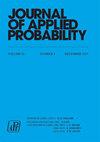迭代函数系统轨迹的指数控制及其在半强GARCH模型中的应用
IF 0.7
4区 数学
Q3 STATISTICS & PROBABILITY
引用次数: 0
摘要
建立了一类迭代函数系统的严格平稳解的新结果。当驱动序列平稳且遍历时,虽然不是独立的,但严格平稳解可能不存在力矩,但我们展示了轨迹的指数控制。我们利用这些结果证明了在温和条件下,具有非独立创新的GARCH(p,q)模型的拟极大似然估计的相合性。本文章由计算机程序翻译,如有差异,请以英文原文为准。
Exponential control of the trajectories of iterated function systems with application to semi-strong GARCH models
We establish new results on the strictly stationary solution to an iterated function system. When the driving sequence is stationary and ergodic, though not independent, the strictly stationary solution may admit no moment but we show an exponential control of the trajectories. We exploit these results to prove, under mild conditions, the consistency of the quasi-maximum likelihood estimator of GARCH(p,q) models with non-independent innovations.
求助全文
通过发布文献求助,成功后即可免费获取论文全文。
去求助
来源期刊

Journal of Applied Probability
数学-统计学与概率论
CiteScore
1.50
自引率
10.00%
发文量
92
审稿时长
6-12 weeks
期刊介绍:
Journal of Applied Probability is the oldest journal devoted to the publication of research in the field of applied probability. It is an international journal published by the Applied Probability Trust, and it serves as a companion publication to the Advances in Applied Probability. Its wide audience includes leading researchers across the entire spectrum of applied probability, including biosciences applications, operations research, telecommunications, computer science, engineering, epidemiology, financial mathematics, the physical and social sciences, and any field where stochastic modeling is used.
A submission to Applied Probability represents a submission that may, at the Editor-in-Chief’s discretion, appear in either the Journal of Applied Probability or the Advances in Applied Probability. Typically, shorter papers appear in the Journal, with longer contributions appearing in the Advances.
 求助内容:
求助内容: 应助结果提醒方式:
应助结果提醒方式:


